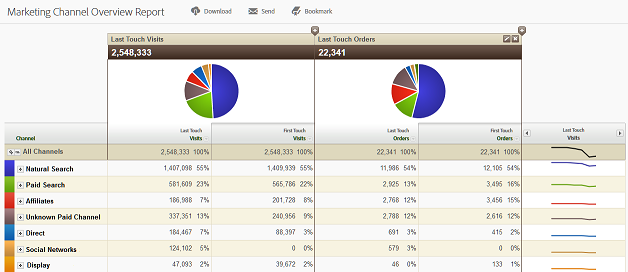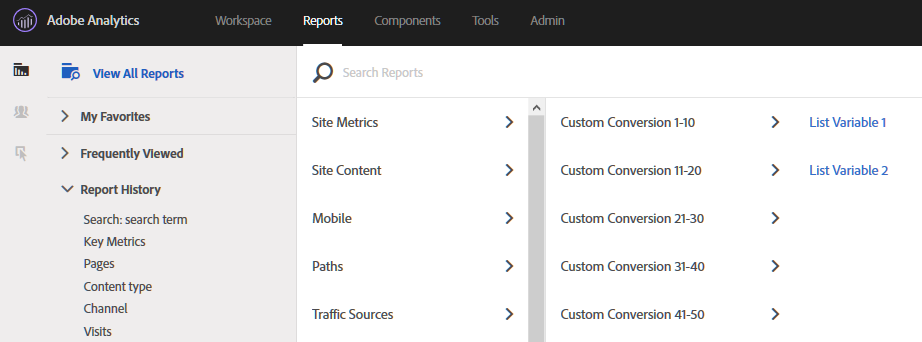Articles by category: Analytics Tips
Message Bus
Unless you have been living in a cave, you should already have a data layer in your websites. OK, maybe that is too harsh; however, at least, you should have a plan to put one in place. Once you have a good data layer, the next step I recommend is that you deploy a message bus.
Basic Analytics Metrics
When I started consulting for Adobe Analytics, I remember I had to explain a few times what the basic analytics metrics are. Once you get used to them, you do not realise it can be difficult to first understand them. So, if you are starting with your web analytics career and are still wondering what exactly a visitor, a hit or a visit is, this blog post is for you.
Clickstream Data Feed
One trend that I have seen in the last few years is the interest of my customers in getting the raw data out of the Adobe Marketing Cloud. More and more corporations are hiring data analysts and these people want all the data they can get. Using various tools (R, Hadoop, Data Workbench…), it is possible to dig deeper into the data to uncover hidden gems or create more sophisticated reports. Today I will explain the raw data from Adobe Analytics, the clickstream data feed.
Processing Rules
Processing rules are basic if-then-else statements to perform minor manipulations of the data. They were added mainly to map context data variables into Analytics variables. However, you can also use them in simple cases instead of a VISTA rule. With processing rules, you can concatenate, copy or set values in Analytics variables. They must not be confused with Marketing Channels processing rules, which are specific for Marketing Channels.
People Identification
One of the main challenge, if not the most important, of digital marketing is to be able to identify real people. This is the key to marketing objectives like “360-degree view of the customers” or “single view of consumers”. The problem is that web analytics tools track only visitors, so we need to find a way to be able to perform this people identification. Let me explain what options do we have.
Share Segments with the Marketing Cloud
If you have followed my previous two posts, you should understand by now the basics of Analytics segments and its containers. I could write more about the creation of the segments, but today I want to explain one of the features that make the Adobe Marketing Cloud a multi-solution offering: share segments. With this feature, you can create a segment in Adobe Analytics and use it in other solutions, like Audience Manager or Target.
Adobe Analytics Segment Containers
In my last post about the basics of Analytics segments, I briefly touched upon the segment containers: hit, visit and visitor. However, I remember how long it took me to understand them initially. And not only me; some of my clients did not find it easy to learn exactly how the different segment containers work. I have decided to explain it so you can understand them once and for all, if you still struggle with them.
Adobe Analytics Segments - The Basics
Those of you who have been long enough in the Web analytics market, will remember that in old version of SiteCatalyst, there was no concept of segmentation. As an alternative solution, you could use ASI slots, DataWarehouse segments or VISTA rules. However, these solutions were clunky, rigid and, sometimes expensive. The Adobe Analytics segments as we now them today come from the release of SiteCatalyst 15. Initially, the tool was still immature, but over time, it has become more sophisticated and it is still evolving. In this post, I will be covering the very basics of segment creation in Adobe Analytics.
Reporting on multiple currencies
Adobe Analytics is very good at reporting on revenue. This metric can be used together with virtually any dimension. You get both granular and high-level views of revenue and you can even track multiple currencies, in case you sell in various regions with different currencies. However, there is one limitation: it is not possible to report on multiple currencies; the reports only show the report suite’s currency. But not all is lost; it is possible to get multiple currencies with a specific implementation, which I am going to show you next.
Marketing Channels Reports
This is the last post of a mini-series on Marketing Channels. By now, you should understand the basics of Marketing Channels, how to mange the channels and how to create new rules. All of this process is necessary to reach the final point, when you can finally use the data for reporting. This is the moment you have been waiting now for some time: use the data for something useful.
Marketing Channels Processing Rules
I am continuing diving into the details of the Marketing Channels tool. So far, I have given an initial introduction to Marketing Channels and explained the Marketing Channels Manager. Today’s post is going to be the most technical of all of them, although I am not going to reference any single line of code. I will explain how to set up the Marketing Channels Processing Rules and their order to get the results that you are expecting.
Marketing Channels Manager
This is the second article about Marketing Channels that I started two weeks ago, with an introduction to Marketing Channels. Today, I will go, step by step, through the process of setting up this tool. Initially, I thought about explaining in one single article how to create the channels and how to configure them. However, I prefer to write shorter posts with more concise information rather than very long articles. So, in in this post, I will concentrate on the initial steps with Marketing Channels.
Marketing Channels Fundamentals
With this post, I am starting a mini-series on Adobe Analytics Marketing Channels. I will be explaining what they are, how to set them up and how to use them in your reports. A quick Google search shows a number of results, including the official documentation, but I want to give a more comprehensive view on them. In this first post, I will get into the fundamentals of Marketing Channels.
How to debug an Adobe Analytics implementation
In my previous post, I stated that you, as a Web analyst, should know the details of the web analytics implementation. It is not enough to just understand how to navigate through the Adobe Analytics UI; you also need to know how the data arrived there in the first place. In this post, I am going to show three different ways to debug an Adobe Analytics implementation. Although this post might look a bit too technical, I believe that everybody involved in web analytics should read it. I know that, too often, we tend to categorise ourselves in “technical” or “business”, but some areas are common to both of these categories and what I am going do describe in this post is one of those areas.
As I mentioned in my previous post about the differences between intent and success, today I am going to talk about my point of view of what a web analyst needs to know regarding the implementation. A few years ago, I was talking with an intern in my office. While talking about her tasks in the company, she told me that she had not followed the official Adobe Analytics training and, instead, she had taught herself the tool. That sentence surprised me a lot and I did not know what to say. I have devoted 5 years to Adobe Analytics and there are still some areas in which I could learn more. How could an intern learn in a few days or weeks enough of Adobe Analytics to use it with confidence, without proper training? Over time, I have been thinking a few times about that comment she made.
Most of you will agree with me that the main task of a web analytics is to analyse the success metrics under different conditions. In general, this means analysing these metrics against different dimensions, segments, dates… This is precisely where Adobe Analytics excels. I will get into more details in a later post, but, as an analyst, you need to know how the data has been collected. One of the typical examples I give to my customers is when I explain them the different between intent and success.
Shopping Cart Abandonment (II)
In my last post, I discussed some general details around the concept of shopping cart abandonment. Let’s now move on to the practical implementation. Depending on the tool, there are various options.
Shopping Cart Abandonment (I)
Have you ever received a request to track and detect online shopping cart abandonments in real time? If you have, then you are not alone. This is a typical request we get from our clients and I have seen too many times. The theory is very simple: if we can detect that a user has added something to the basket but has not purchased it, then we need to persuade him to finish the process. However, the reality is more complicated than just that. Let me explain what I usually discuss with my customers and what options do we have.
Track chatbots using Adobe Analytics
According to some news, all major Internet players are now focusing on chatbots. I have never used one but it looks like with the progress in artificial intelligence, we will all be using them in the not-so-distant future. Facebook even claims that thousands of developers are creating right now chatbots. If this is true, then we should be ready for them. While I read this news, I thought, how about using Adobe Analytics to track the conversations? Would it make sense to large corporations, which already have Adobe Analytics, to use the same tool as with website and apps? I know some people will contend that my idea is wrong, that chatbots will need a different reporting tool. However, I would then reply that, a few years ago, it was not clear whether Adobe Analytics would be used for apps; now, all my clients, want to integrate Adobe’s SDK in all their apps.
Limits of web analytics
This is going to be a rather short post, but only from my side, as the poster: if you follow everything I am saying, it will be even longer for you to process than any of my previous posts. Let’s start by watching the one of the great TED talks: Sebastian Wernicke: How to use data to make a hit TV show


















